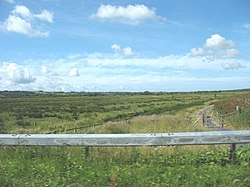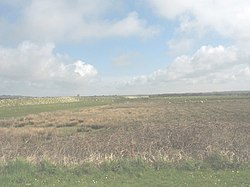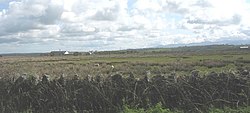Malltraeth Marsh

Malltraeth Marsh is a large marsh area in Anglesey, located northeast of Malltraeth village, north of Llangaffo and south of Rhostrehwfa. It is reclaimed from estuarine marshes after the construction of the Malltraeth Cob (dyke), a 1 mile-long embankment,[1] and the subsequent canalisation in 1824 of the River Cefni.[2]
The name Malltraeth comes from Mall ("bad"), and Traeth ("sandy shore").[3] The area is recognized as a Site of Special Scientific Interest (SSSI), and has a range of reedbeds, marshes, wet grassland and small pools/lakes.[4]
History

In 1790, an act of parliament was obtained for more effectually embanking the marshes called Malltraeth and Corsddeuga, under the provisions of which 230 acres were allotted to the several proprietors of land in the parish of Llangaffo.[5] The 4000 acres of reclaimed alluvium at the mouth of the River Cefni subsequently underwent considerable improvements in the late 18th century and early 19th century with the introduction of embankments and flood mitigation measures.[6] During First World War, further improvements were made due to the concern of farmers. However the reclamation became neglected and by the end of the war it had fallen into a bad state and was subject to numerous heated conflicts between the drainage engineer, the CWAEC, and the underfunded catchment board managing the drainage of the marsh.[6] Bitter disputes over the marsh reached a climax with the chairman resigning from the Malltreath Marsh subcommittee in March 1942 and unusually high rainfall during the harvest in the following year devastating most of the cereal crops in the area.[6] Due to pressure from local farmers, Lord Anglesey met with Robert Hudson and Megan Lloyd George in 1944 to outline ideas for improving the local habitat problem.[6] Some £100,000 was allocated to developing what was about 50% derelict marsh during the war and by 1947, £147,000 had been spent on the scheme.[6]

Geography


Located in the Commote of Malltraeth,[3] the Malltraeth Marsh valley crosses Anglesey parallel to the Menai Straits, approximately 4 miles to the northwest.[7] The habitat Malltraeth Marsh consists of marshy grasslands, lakes, pools, fossiliferous coal and shales.[8]
The marsh's geology is characterized by carboniferous limestone, millstone grit, soft coal-measure shales, sandstone, beds of coal, and Permian strata.[9] The valley is 9 miles long and runs almost exactly parallel to the valley of the Menai Straits. Many years ago, at its north-eastern end, deep glacial striatums on the Millstone Grit ran straight down the shallow valley towards Caernarfon Bay.
Malltraeth Marsh is a wide and perfectly flat expanse of reedy pasture. On its far side, there is an embanked tidal river that opens to Malltraeth Sands, half a mile to the south. A short tunnel, the first one in Anglesey, pierces the low hills which extend along the west side of Malltraeth Marsh before reaching Bodorgan railway station.[10] Above Malltraeth lies the extensive Common of the marsh, which is bounded on the northwest by the parishes of Llangadwaladr, Trefdraeth, and Llangristiolus; on the northeast by Llangefni and Llanffinan; and on the southeast by Llanfihangel-y-Ceifiog, Llanidan, Llangaffo, Llangeinwen, and Newborough.[3]
Vegetation
The vegetation reported from the Malltraeth Marsh consist of reed canary-grass, water-plantain, branched bur-reed, Club rush and reed sweet-grass. Spiked water-milfoil, blunt-leaved pondweed, horned pondweed are also reported in the marsh land, apart from rare species of flowering-rush, water-violet and marsh stitchwort.[8]
Fauna
Water voles inhabit the marsh. Birds such as Lapwing, Curlew, Redshank and Snipe are reported from the lowland wet grassland. Teal, Shoveler Gadwall and Pochard occupy the open water.[8] Other birds recorded are Bittern and Grey Heron.[8] Invertebrates include water beetles (Hydrochus brevis) and Hairy Dragonflies.
Conservation

Malltraeth Marsh is a Site of Special Scientific Interest. It is notable for its breeding bird community, its lowland damp grassland, its reedbeds, the threatened habitat of wet meadows, and the botanical importance of its ditches and watercourses.[11] A Royal Society for the Protection of Birds reserve is situated in the northeast corner of the SSSI.[4]
Management options undertaken to conserve the marsh land consists of: Maintaining water levels by proper upkeep of clay lined ditches to conserve flora and fauna; maintaining an exclusive swamp area to breed bittern; creation of shallow water ditches along old water courses to drain large land areas where waders can feed; establishing water control structures on secondary drains to maintain high ground water table during the spring season; control of introduced invasive plant species such as fairy fern, Australian stonecrop and Himalayan balsam; reduce risk of predation (by predators such as crows and minks) of birds by constant conservation and preservation of hedges; encouraging grazing during winter season and reducing it during summer to attract ground nestling birds; and controlled agricultural management to provide nestling sites for waders.[8]
References
- ↑ "Welcome to the Malltraeth Ymlaen Frontpage". malltraeth.com. http://malltraeth.com/. Retrieved 14 August 2011.
- ↑ "Malltreath Marsh/Cors Ddyga SSSI". angleseynature.co.uk. http://angleseynature.co.uk/webmaps/malltraeth.html. Retrieved 14 August 2011.
- ↑ 3.0 3.1 3.2 Carlisle, Nicholas (1811). A topographical dictionary of ... Wales, a continuation of the topography of the United Kingdom of Great Britain and Ireland (Now in the public domain. ed.). pp. 446–.
- ↑ 4.0 4.1 "Malltraeth Marsh". rspb.org.uk. http://www.rspb.org.uk/reserves/guide/m/malltraethmarsh/index.aspx. Retrieved 14 August 2011.
- ↑ "LLANGAFFO". Genuki.org. http://www.genuki.org.uk/big/wal/AGY/Llangaffo/index.html. Retrieved 13 August 2011.
- ↑ 6.0 6.1 6.2 6.3 6.4 Clout, Hugh D.; Munton, R. J. C. (2007). Contemporary rural geographies: land, property, and resources in Britain : essays in honour of Richard Munton. Routledge. p. 31. ISBN 978-0-415-43183-5.
- ↑ Woodward, Henry (1876). Geological magazine (Now in the public domain. ed.). Cambridge University Press. pp. 134–.
- ↑ 8.0 8.1 8.2 8.3 8.4 "Malltreath Marsh/Cors DDYGA, Site of Special Scientific Interest". Countryside Council for Wales. http://angleseynature.co.uk/webmaps/malltraethmarshsms.html. Retrieved 15 August 2011.
- ↑ The Assistant-Secretary of the Geological Society (1876). The Quarterly Journal of the Geological Society of London (Now in the public domain. ed.). pp. 120–.
- ↑ Baddeley, Mounftord John Byrde (1884). North Wales (part 1) Chester, Rhyl, Llandudno, Bangor etc. (Now in the public domain. ed.). Dulau & Co.. pp. 95–.
- ↑ "Anglesey Malltraeth Marsh / Cors Ddyga National Grid reference: SH440710". angleseynature.co.uk. http://angleseynature.co.uk/webmaps/malltraethmarshdesc.htm. Retrieved 14 August 2011.